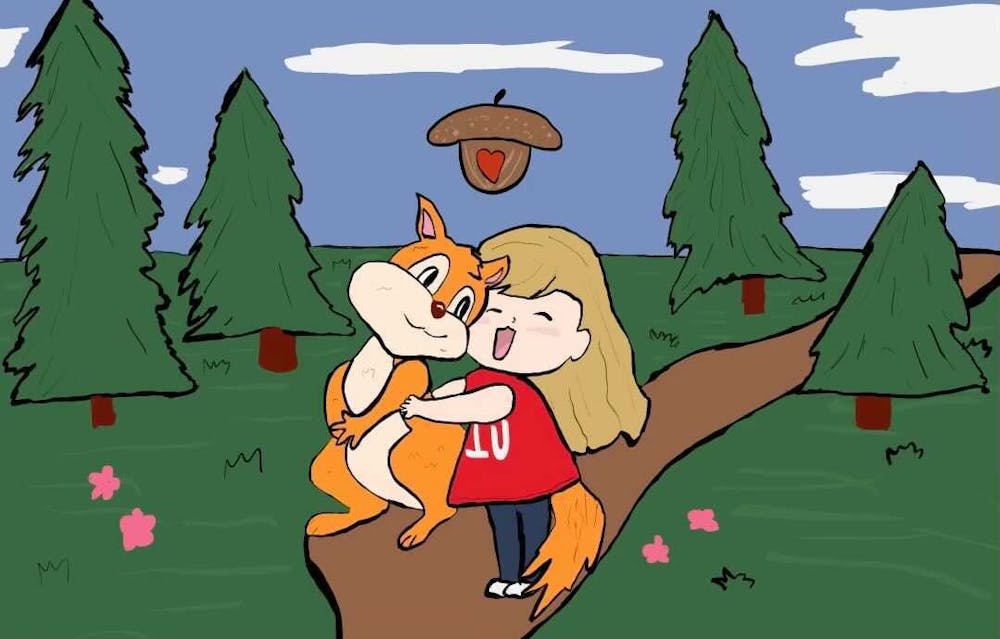As I walk around campus, I see them grouping together, scurrying up trees and chasing each other or shoving an acorn into the earth. Their little tufts of fur stand out against the dark green grass as they scamper their way along the map in their mind, and their carefully built nests stand in the bare tree branches of February like knots on a string.
Red fox squirrels are practically everywhere on IU’s campus, and oftentimes I find myself wondering, “Where did you all come from?” Apparently, the growing population of squirrels is due to many factors, some being people’s want to create a natural and community-based atmosphere within cities.
Red fox squirrels are found throughout Central and North America and have expanded into other parts of western North America. Since then, they have been further introduced to areas such as northern Mexico and Canada.
[Related: COLUMN: The acorn assembly: a squirrel and student love affair]
These Hoosier squirrels seem to have family members across the world and have become known for their round build, fluffy tails and friendliness with humans. One of these family members includes the eastern gray squirrel, who was brought into up and coming cities in the 1800s with the goal of protecting pieces of nature within the concrete jungle.
Seeing these eastern grays was new and exciting to the people who inhabited these cities. Oftentimes, the squirrels were provided with peanuts to help them make it through winter. At one point, the eastern gray squirrels were consuming up to 75 pounds of peanuts weekly. So, it seems the idea of a human and squirrel companionship is nothing new.
When squirrels were first introduced to cities such as New York City, they were considered a rarity. Similar to the love that the red fox squirrels have gained from students across IU’s campus, they were highly appreciated.
On IU’s campus, the red fox squirrels are known to be particularly social and can oftentimes be seen chasing one another across long distances of grass, or around tree trunks.
I have seen how the student population acts towards these squirrels and can see how their sociability is put to use. I’ll see a squirrel walk up to a smiling student or a student bend down to allow the squirrel to sniff their hand.
Within cities, most people are still able to appreciate the squirrels’ presence. But, over time, the squirrels have begun to blend into the concrete jungle. As squirrels continue to grow in numbers, their rarity decreases, therefore decreasing people’s interest in them.
[Related: OPINION: The dos and don'ts of Hoosier squirrels]
In an article written by The Atlantic, some even identify squirrels as “tree rats,” declaring that the only difference between them and a rat is that one is fluffier than the other.
After reading that article, I was a little distraught that the red fox squirrel used to be considered such a rarity and are now deemed less charming than before. It’s as though by seeing squirrels all of the time, we may forget the kind of treasure that they really are.
I think that nature as a whole may be viewed this way by most of our society today. The Midwest landscape may seem boring and commonplace to some nowadays, but I think it still deserves to hold the same value that was held by the first indigenous people of this land.
By keeping an appreciation for the squirrels on our campus, I think we can also better understand how to better appreciate nature as a whole.
I am unsure how the entire IU student population feels towards their squirrels, but I believe that most can say that the squirrels are more than “tree rats.” I also think that because of this, more people can see the beauty of the trees, grass and flowers as well. The squirrels have kept their ability to amaze students and faculty alike and will most likely do so for years to come. Who knows what other landscapes they will populate in the future?
Carolyn Marshall (she/her) is a sophomore majoring in media studies with a focus in TV, digital and film production and minoring in English.






